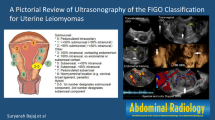Abstract
To elucidate the impact of radical hysterectomy upon the urodynamic findings of patients with cervical cancer, 20 patients with cervical cancer at stage IB to IIA who underwent radical hysterectomy were recruited. Each patient underwent a 20-min pad test and urodynamic study prior to and 3 months after radical hysterectomy. ANOVA, Bonferroni test and paired t -test were utilized for analysis. The mean age of the 20 patients was 50.2±8.7 years with a mean parity of 3.5±1.5. Four (20%) of the 20 cases revealed normal urodynamic findings preoperatively, and the urodynamic findings became abnormal after surgery. Comparing the urodynamic parameters of both bladder voiding and storage functions pre- and post-surgery, we found significant impairments postoperatively in all 20 cases. Our data demonstrate that abnormal urodynamic findings may pre-exist for some patients with cervical cancer prior to surgical treatment. These findings may worsen, and/or additional abnormal states may arise subsequent to radical hysterectomy.
Similar content being viewed by others
Abbreviations
- GSI:
-
Genuine stress incontinence
- MUCP:
-
Maximal urethral closure pressure
- MUP:
-
Maximal urethral pressure
References
Forney JP (1980) The effect of radical hysterectomy on bladder physiology. Am J Obstet Gynecol 138:373–382
Kadar N, Salbia N, Nelson JH (1983) The frequency, causes and prevention of severe urinary dysfunction after radical hysterectomy. Brit J Obstet Gynaec 90:858–863
Vervesst HAM, Barents JW, Haspels AA, Debruyne FMJ (1989) Radical hysterectomy and the function of the lower urinary tract. Acta Obstet Gynecol Scand 68:331–340
Stolz W, Walliener D, Brandner P, Grischke E, Bastert G (1989) Detrusor and compliance changes of the bladder after radical hysterectomy. Eur J Gynecol Oncol 10:378–383
Hamada K, Kihana T, Takada Y, Inoue Y, Matsuura S, Kataoka M, et al (1992) Urodynamic study on urinary disturbance after therapy of uterine cancer. Acta Obstet Gynecol Jpn 44:440–446
Iio S, Yoshioka S, Nishio S, Yokohama M, Iwata H, Takeuchi M (1993) Urodynamic evaluation for bladder dysfunction after radical hysterectomy. Jpn J Urol 84:535–540
Lin HH, Sheu BC, Lo MC, Huang SC (1998) Abnormal urodynamic findings after radical hysterectomy or pelvic irradiation for cervical cancer. Int J Gynecol Obstet 63:169–174
Westby M, Asmussen M (1985) Anatomical and functional changes in the lower urinary tract after radical hysterectomy with lymph node dissection as studied by dynamic urethrocystography and simultaneous urethrocystometry. Gynecol Oncol 21:261–276
Farquharson DIM, Shingleton HM, Soong SJ, Sanford SP, Levy DS, Hatch KD, et al (1987) The adverse effects of cervical cancer treatment on bladder function. Gynecol Oncol 27:15–23
Scotti RJ, Bergman A, Bhatia NN, Ostergard DR (1986) Urodynamic changes in urethrovesical function after radical hysterectomy. Obstet Gynecol 68:111–120
Lin HH, Yu HJ, Sheu BC, Huang SC (2001) Importance of urodynamic study before radical hysterectomy for cervical cancer. Gynecol Oncol 81:270–272
Snad PK, Ostergard DR (1995) Pad testing. In: Sand PK, Ostergard DR, editors. Urodynamics and the evaluation of female incontinence: a practical guide. Springer-Verlag, London, pp 20–23
Schafer W, Abrams P, Liao L, Mattiasson A, Pesce F, Spangberg A, Sterling AM, et al (2002) Good urodynamic practices: uroflowmetry, filling cystometry, and pressure-flow studies. Neurourol Urodynam 21:261–274
Lose G, Grifiths D, Hosker G, Kulseng-Hanssen S, Perucchini D, Schafer W, et al (2002) Standardisation of urethral pressure measurement: report from the standardization sub-committee of the International Continence Society. Neurourol Urodynam 21:258–260
Abrams P, Cardozo L, Fall M, Griffiths D, Rosier P, Ulmsten U, et al (2002) The standardization of terminology of lower urinary tract function: report from the standardization sub-committee of the International Continence Society. Neurourol Urodynam 21:167–178
Blaivas JG, Appell RA, Fantl JA, Leach G, McGuire EJ, Resnick NM, et al (1997) Definition and classification of urinary incontinence: recommendations of the urodynamic society. Neurourol Urodynam 16:149–151
Lin HH, Cheng WF, Chan KWA, Chang DY, Chen CK, Huang SC (1996) Risk factors for recurrence in patients with stage IB, IIA and IIB cervical carcinoma after radical hysterectomy and postoperative pelvic irradiation. Obstet Gynecol 88:274–279
Chen GD, Lin TL, Hu SW, Chen YC, Lin LY (2003) Prevalence and correlation of urinary incontinence and overactive bladder in Taiwanese women. Neurourol Urodynam 22:109–117
Seski JC, Diokno AC (1997) Bladder dysfunction after radical abdominal hysterectomy. Am J Obstet Gynecol 128:643–651
Sasaki H, Yoshida T, Noda K, Yachiku S, Minami K, Kaneko S (1982) Urethral pressure profiles following radical hysterectomy. Obstet Gynecol 59:101–104
Oguchi K, Kuwabara M, Sakuragi N, Ohkouchi T, Yamamoto R, Fujino T, et al (1999) Urodynamic study for bladder dysfunction following radical hysterectomy. Acta Obst Gynaec Jpn 51:325–334
Author information
Authors and Affiliations
Corresponding author
Additional information
Editorial Comment: This paper is interesting because of the attempt at getting longitudinal urodynamic data on patients undergoing radical hysterectomy. All diagnosis and data are based on urodynamic findings. The patients serve as their own controls and only 20% were normal before surgery. Urodynamic data are useless in the absence of clinical correlation, and only provide a photographic and not cinematic view of bladder function. I believe it to be critical to include such information to evaluate the value of the information presented if it were to add to our knowledge of bladder dysfunction following radical hysterectomy. Further studies with control groups with no surgery and with regular hysterectomy would add worthwhile information regarding the true impact of radical hysterectomy for cervical cancer on the lower urinary tract function.
Rights and permissions
About this article
Cite this article
Lin, LY., Wu, JH., Yang, CW. et al. Impact of radical hysterectomy for cervical cancer on urodynamic findings. Int Urogynecol J 15, 418–421 (2004). https://doi.org/10.1007/s00192-004-1187-z
Received:
Accepted:
Published:
Issue Date:
DOI: https://doi.org/10.1007/s00192-004-1187-z




